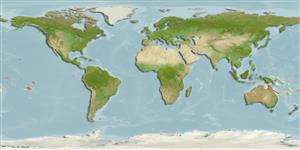Klassifizierung / Names
Namen | Synonyme | Catalog of Fishes(Gattung, Arten) | ITIS | CoL | WoRMS | Cloffa
>
Eupercaria/misc (Various families in series Eupercaria) >
Labridae (Wrasses) > Bodianinae
Etymology: Bodianus: Bodianus after Bodiano or Pudiano, from the Portuguese pudor, meaning modesty (Jordan & Evermann, 1896).; bennetti: Named for Timothy Bennett, the collector of the holotype of this new species..
Environment: milieu / climate zone / depth range / distribution range
Ökologie
seewasser riff-verbunden; tiefenbereich 97 - 130 m (Ref. 82450). Tropical
Western Pacific: off the northeastern coast of Queensland (Coral Sea) and French Polynesia (Moorea)..
Size / Gewicht / Alter
Maturity: Lm ? range ? - ? cm
Max length : 10.9 cm SL Männchen/unbestimmt; (Ref. 82450)
Kurzbeschreibung
Morphologie | Morphometrie
Rückenflossenstacheln (insgesamt): 12; Rückenflossenweichstrahlen (insgesamt): 10; Afterflossenstacheln 3; Afterflossenweichstrahlen: 12; Wirbelzahl: 28. This species of the subgenus Trochocopus is distinguished by the following characters: pectoral-fin rays ii,15; lateral-line scales 42 + 2; scales above lateral line 4.5, scales below lateral line 13; predorsal scales 11; total gill rakers 12; shallow body its depth 25.0% SL; eye of moderate size with orbital diameter 7.0% SL; interorbital space narrow, 6.4% SL; caudal peduncle shallow, 13.2% SL; short posterior lobes on dorsal (11.1% SL) and anal (10.0% SL) fins; pectoral fin short, 18.0% SL; pelvic fin of moderate length, 16.1% SL, its tip reaching midway between fin origin and anus; posterior corner of mouth below anterior extent of orbit; upper jaw with length of first prominent anterior canine about equal length of second; dental ridge is smooth with regular series of granular teeth, single prominent canine at posterior end of jaw; lower jaw with first prominent anterior canine about half length of second; dental ridge with about 10 small erect canines increasing slightly in length from front to back, followed by about 8 shorter teeth; no vomerine teeth; pelvic fin short, tip reaching just beyond anus; body with 3 broad, red, lengthwise stripes separated by lemon-yellow or white stripes with lowermost red stripe not continuing anteriorly onto head, prominent black spot on middle red stripe on operculum behind eye and black pigmentation on membranes between first 3 or 4 dorsal-fin spines; juveniles have a prominent black spot at posterior end of middle red stripe on scaly caudal-fin base, which turns red in initial-phase adults and becomes more prominent in terminal-phase adults (Ref. 82450).
This species was observed on a gentle slope, over clean rubble, in a highcurrent area (Ref. 82450).
Life cycle and mating behavior
Geschlechtsreife | Fortpflanzung | Ablaichen | Eier | Fecundity | Larven
Gomon, M.F. and F. Walsh, 2016. A new pygmy hogfish (Labridae: Bodianus) of the subgenus Trochocopus from the tropical southern Pacific Ocean. J. Ocean Sci. Found. 23:12-20. (Ref. 82450)
IUCN Rote Liste Status (Ref. 130435)
Bedrohung für Menschen
Harmless
Nutzung durch Menschen
Mehr Information
NamenSynonymeMetabolismusRäuberÖkotoxikologieFortpflanzungGeschlechtsreifeAblaichenSpawning aggregationFecundityEierEientwicklung
Alter/GrößeWachstumLänge-GewichtLänge-LängeLängenhäufigkeitenMorphometrieMorphologieLarvenLarven Pop.Dyn.RekrutierungDichteBRUVS
ReferenzenAquakulturAquakultur ProfilZuchtlinienGenetikElectrophoresesVererbbarkeitKrankheitenVerarbeitungNutrientsMass conversion
PartnerBilderStamps, Coins Misc.LauteCiguateraGeschwindigkeitSchwimmstilKiemenoberflächeOtolithsGehirngrößeSehfähigkeit
Tools
Zusatzinformationen
Download XML
Internet Quellen
Estimates based on models
Phylogenetic diversity index (Ref.
82804): PD
50 = 0.5000 [Uniqueness, from 0.5 = low to 2.0 = high].
Bayesian length-weight: a=0.01202 (0.00551 - 0.02625), b=3.05 (2.87 - 3.23), in cm total length, based on LWR estimates for this Genus-body shape (Ref.
93245).
Trophic level (Ref.
69278): 3.3 ±0.5 se; based on size and trophs of closest relatives
Widerstandsfähigkeit (Ref.
120179): hoch, Verdopplung der Population dauert weniger als 15 Monate. (Preliminary K or Fecundity.).
Fishing Vulnerability (Ref.
59153): Low vulnerability (10 of 100).
